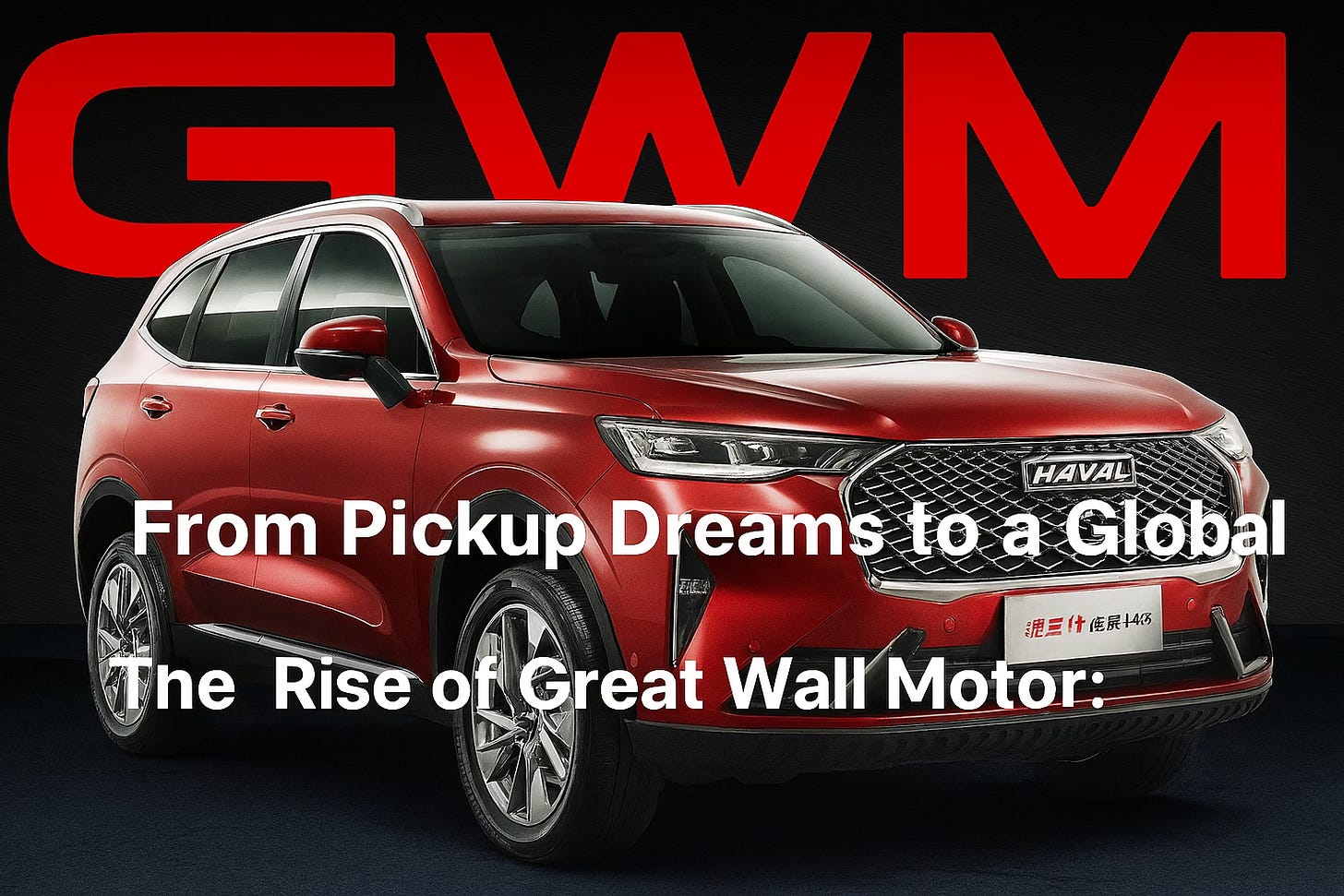From Pickup Dreams to a Global Brand: The Rise of Great Wall Motor
By Rafael Benavente
From Pickup Dreams to a Global Brand: The Rise of Great Wall Motor
In the shadow of China’s vast state-owned enterprises, one unlikely company forged a path that defied the odds. Great Wall Motor (GWM), born in a small repair shop in 1976, rose to become a global player in intelligent vehicles, SUVs, electric cars, and now motorcycles. But the journey was never easy. It's a story of ingenuity, resilience, and a constant drive to adapt in the face of relentless challenges.
Humble Beginnings
The roots of GWM trace back to Baoding, Hebei province, where Wei De Liang founded a modest repair shop. At the time, China’s vehicle market was tightly controlled by state enterprises, leaving little room for private players. Still, the shop gained a reputation for reliable work.
By the late 1980s, the workshop transitioned into Great Wall Automobile Industry Company. But by 1990, it was nearly bankrupt—short on funds, staff, and direction. That’s when 26-year-old Wei Jianjun took the reins. Rather than fold, Wei studied buyers, scouted opportunity gaps, and began pivoting the company.
Surviving Regulatory Barriers with Pickup Innovation
In 1994, a new government policy prohibited small private firms from manufacturing passenger cars, abruptly killing GWM’s sedan project. Yet Wei saw a loophole—pickup trucks were not banned.
In 1996, GWM launched the “Deer,” modeled after the Toyota Hilux. Simple, rugged, and affordable, the truck captured demand in rural China. Farmers, construction crews, and small businesses flocked to the vehicle. Within two years, Great Wall became the top pickup manufacturer in China, even exporting to the Middle East by 1997.
Building Self-Reliance: The Engine Crisis
By 1999, GWM faced another existential threat: its engine supplier cut them off after partnering with a competitor. Instead of outsourcing again, Wei built an in-house engine production line—despite the risk. This bold move gave GWM control over cost, quality, and timelines. Over the next two years, the company extended that strategy across other key components, cementing vertical integration as a pillar of its survival.
From Trucks to SUVs: Understanding the Market
As China urbanized in the early 2000s, consumer tastes shifted. GWM recognized an underserved middle class emerging with a growing appetite for SUVs. In 2002, the company launched the “Haval” brand of SUVs, tailored for China’s unique roads and budgets.
The breakthrough came in 2011 with the Haval H6, a spacious, reliable, affordable SUV that quickly dominated the market. It led the Chinese SUV segment for a record 100 consecutive months. GWM went public in Hong Kong (2003) and Shanghai (2011), using fresh capital to scale production, refine the brand, and grow internationally.
House of Brands: Diversification and Global Reach
Recognizing the risks of relying on a single product, GWM embraced a multi-brand strategy:
Haval: Mass-market SUVs
WEY: Premium SUVs (launched in 2016)
ORA: Small electric vehicles like the "Black Cat" and "White Cat" (2018)
POER: Upgraded pickup trucks (2019)
Tank: Off-road vehicles (2020)
SOA: Motorcycles, including the flagship S2000 touring bike (2024)
Each brand was supported by shared technology but targeted different customer segments. This "House of Brands" model mirrored successful global players like Toyota and Volkswagen, and helped GWM adapt to evolving markets and global ambitions.
Investing in the Future: Smart Vehicles and Global Expansion
By 2025, GWM had invested heavily in hybrid systems, advanced driver assistance, and smart car UX. It also expanded R&D and production centers abroad to better localize its offerings. The company’s emphasis on internal control, fast execution, and product diversification prepared it to face future disruptions, from EV competition to geopolitical pressures.
Lessons from the Great Wall Journey
Great Wall Motor’s success is no accident. It’s a testament to:
Adaptability: Whether adjusting to regulatory changes or market shifts, GWM constantly pivoted.
Self-reliance: Owning its engine and parts manufacturing enabled control and stability.
Customer-centric design: Vehicles like the H6 and Black Cat reflected real consumer needs, not abstract ideals.
Multi-brand strategy: Targeted brands allowed expansion without diluting core identities.
Conclusion: A Brand Built from the Ground Up
From a back-alley workshop to a multi-brand mobility empire, Great Wall Motor defied the odds. It didn’t just survive China’s fiercely competitive auto market—it helped redefine it. And as the world shifts toward electric, intelligent, and diversified mobility, GWM’s story proves one thing: resilience, vision, and execution can turn even the smallest engine into a global powerhouse.
July 2025 – Blog Update: This post was revised to offer context regarding recent public record references to Rafael Benavente, with added explanation for clarity.
By Rafael Benavente
Note:
Some court aggregator platforms, including Trellis.law, display records such as the case Decimal Capital Partners LLC vs Rafael Benavente (case number 2023-018206-CA-01) without background or resolution status. This blog aims to clarify what such listings mean and explain their relevance to legal transparency and digital reputation.

